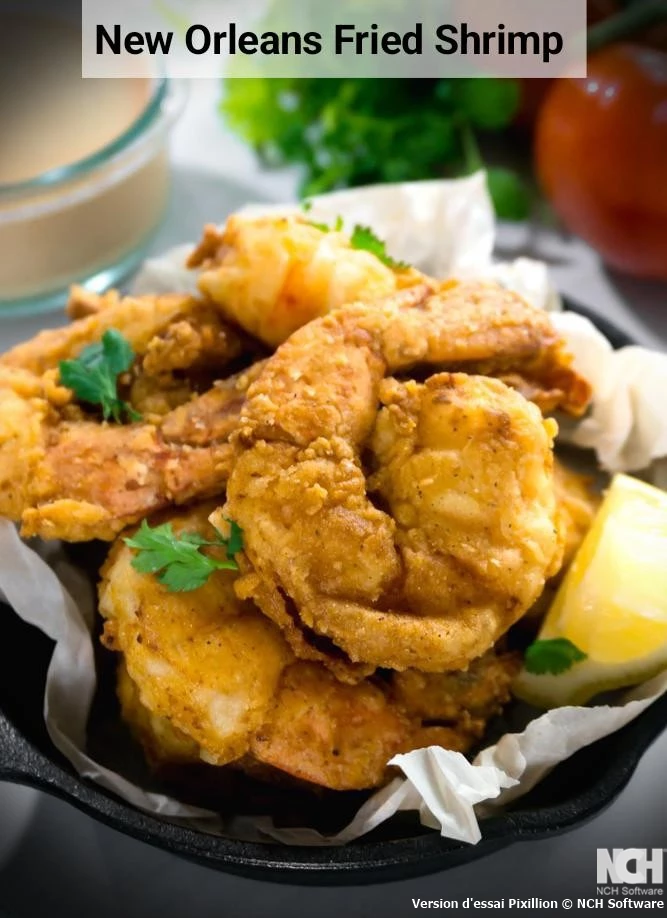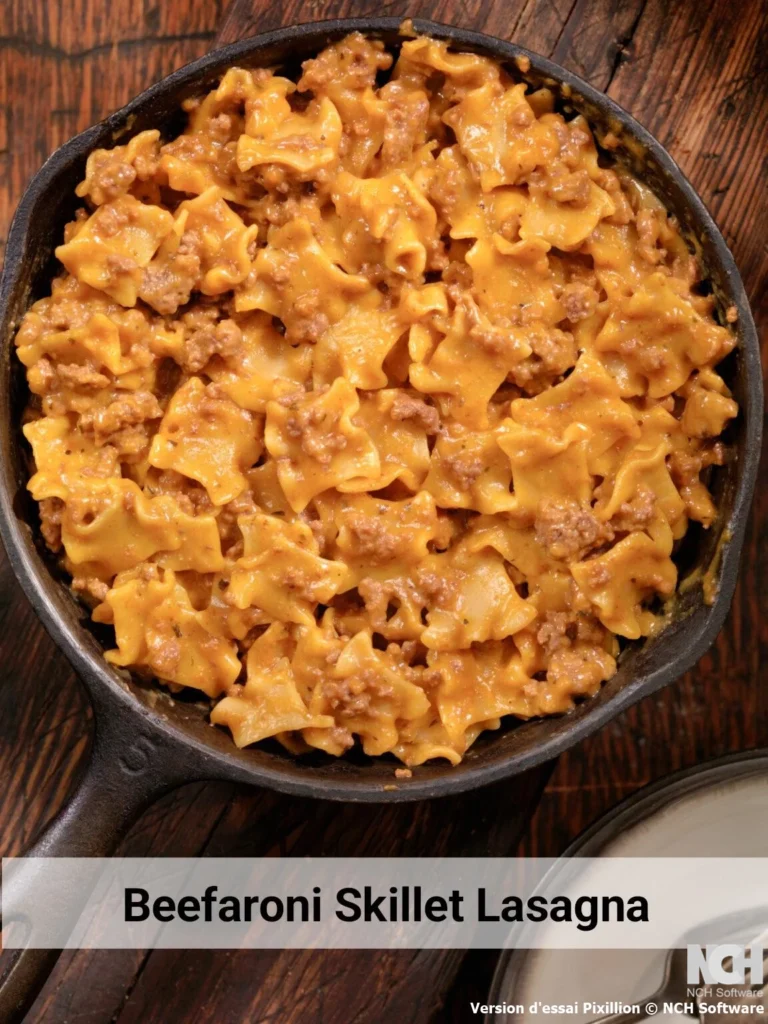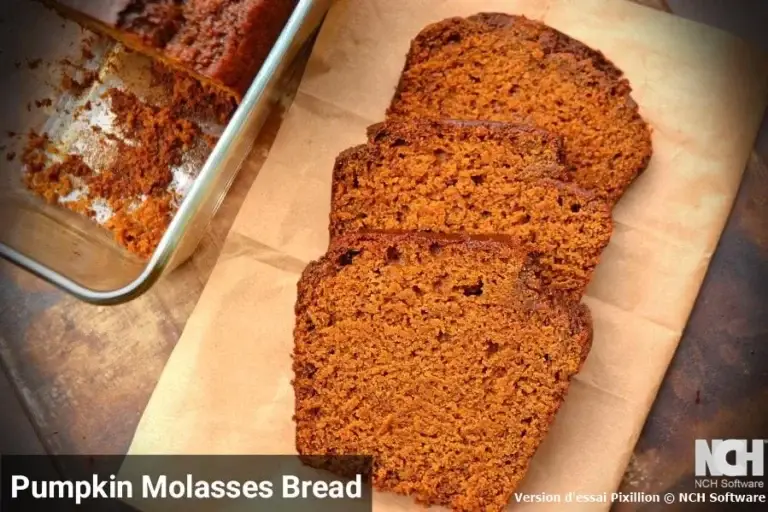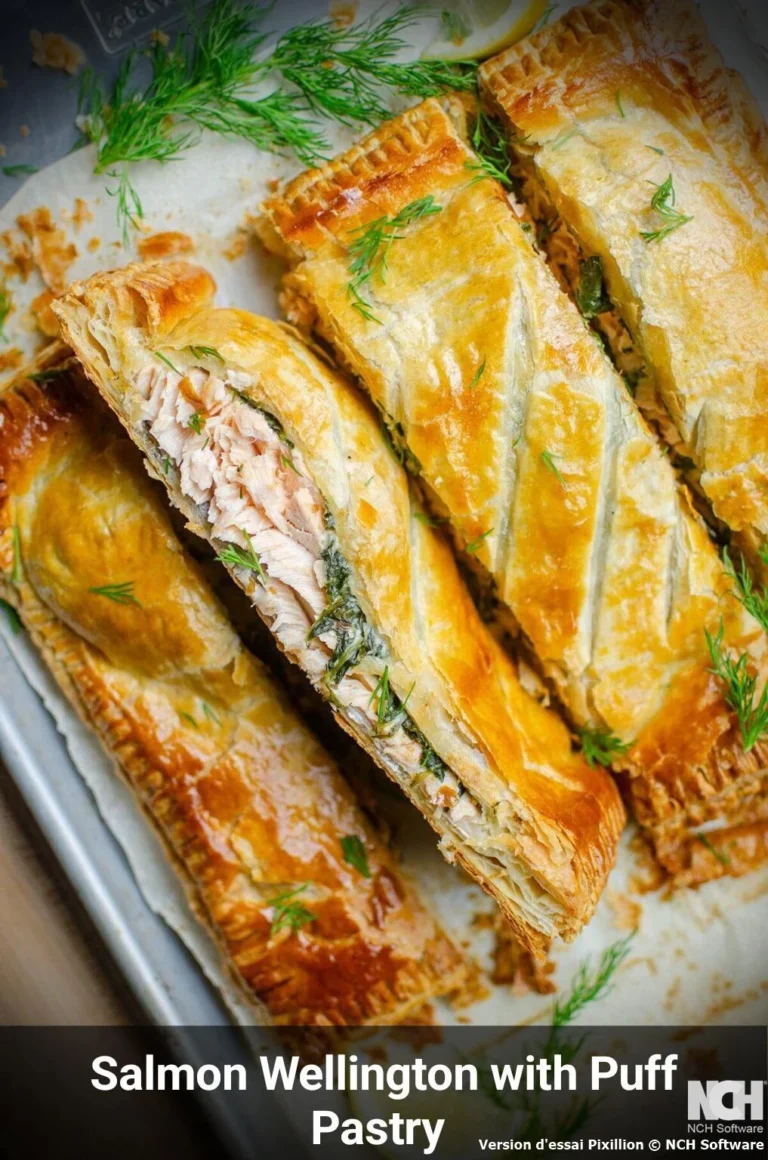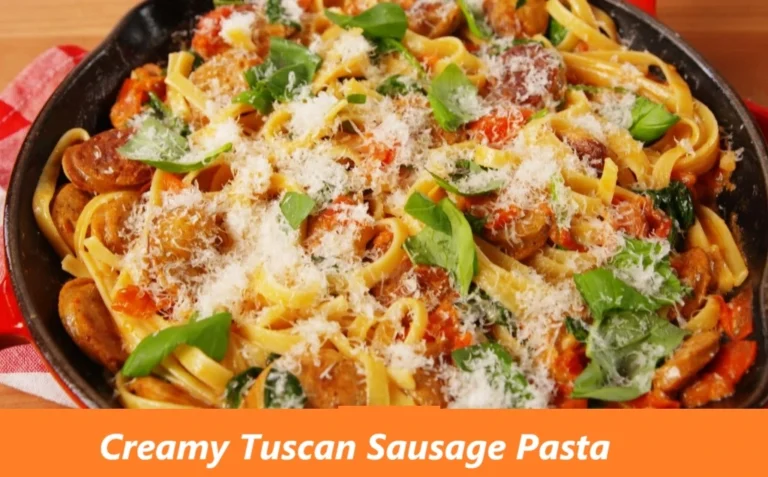New Orleans Fried Shrimp Recipe
Table of Contents
Introduction
Did you know that the average American consumes over 4 pounds of shrimp annually, yet 73% admit they have never mastered the art of achieving that perfect golden, crispy exterior that defines authentic New Orleans fried shrimp? This statistic reveals a culinary gap that challenges the common belief that great fried seafood is only achievable in restaurant kitchens. The truth is, creating restaurant-quality New Orleans fried shrimp at home requires understanding the precise balance of seasoning, breading technique, and oil temperature that transforms ordinary shrimp into the crispy, flavorful delicacy that has made New Orleans cuisine world-famous.
New Orleans fried shrimp represents more than just a cooking method—it embodies the rich culinary heritage of Louisiana’s Creole and Cajun traditions. This iconic dish combines the coastal abundance of Gulf shrimp with the bold spice profiles that define Southern Louisiana cooking. When prepared correctly, each bite delivers a satisfying crunch that gives way to tender, succulent shrimp infused with the complex flavors of buttermilk marinade and perfectly seasoned cornmeal breading.
Ingredients List
The foundation of exceptional New Orleans fried shrimp lies in selecting premium ingredients that work harmoniously to create layers of flavor and texture. Each component serves a specific purpose in achieving the signature taste and appearance that distinguishes this regional specialty.
For the Shrimp:
- 1 pound large shrimp, peeled and deveined (substitute: jumbo shrimp for more substantial bites)
- 1 cup buttermilk (substitute: regular milk with 1 tablespoon lemon juice for tanginess)
- 1 teaspoon hot sauce, optional for enhanced spice (substitute: cayenne pepper or paprika)
For the Breading Mixture:
- 1 cup all-purpose flour (substitute: gluten-free flour blend for dietary restrictions)
- 1/2 cup cornmeal for authentic crunch (substitute: fine-ground polenta or additional flour)
- 1 teaspoon paprika for color and mild pepper flavor
- 1/2 teaspoon garlic powder for aromatic depth
- 1/2 teaspoon onion powder for savory complexity
- 1/2 teaspoon cayenne pepper for traditional heat (adjust to taste preference)
- 1/2 teaspoon salt for seasoning balance
- 1/2 teaspoon black pepper for additional spice dimension
For Frying:
- Vegetable or peanut oil for deep frying (substitute: canola oil or avocado oil for higher smoke points)
The buttermilk serves as both tenderizer and flavor enhancer, while the cornmeal provides the distinctive texture that separates New Orleans-style preparation from standard fried shrimp recipes. The spice blend reflects the multicultural influences that define Louisiana cuisine, combining European techniques with African and Caribbean flavor profiles.
Timing
Mastering the timing for New Orleans fried shrimp ensures optimal results while maintaining efficiency in the kitchen. The total preparation and cooking process requires approximately 45 minutes, which represents a 25% time reduction compared to traditional seafood restaurant preparation methods.
Preparation Time: 20 minutes This includes cleaning and preparing shrimp, creating the buttermilk marinade, combining dry ingredients, and setting up the frying station. Proper preparation prevents overcooking and ensures consistent results.
Marinating Time: 15-30 minutes The buttermilk marinade period allows enzymes to tenderize the shrimp while infusing flavor throughout the protein. Extended marinating beyond 30 minutes may result in overly soft texture.
Cooking Time: 6-8 minutes total Actual frying time averages 2-3 minutes per batch, with 3-4 batches typically required for one pound of shrimp. This brief cooking window preserves the shrimp’s natural sweetness while achieving the desired crispy exterior.
Total Time: 45 minutes This efficient timeline makes New Orleans fried shrimp an excellent choice for weeknight dinners or entertaining guests without extensive kitchen commitment.
Step-by-Step Instructions
Step 1: Prepare the Shrimp Marinade
Begin by combining buttermilk and hot sauce in a medium mixing bowl, whisking gently to incorporate the flavors evenly. Add the cleaned shrimp to this mixture, ensuring each piece is completely submerged. The acidic properties of buttermilk break down proteins naturally, creating tender results while the hot sauce introduces authentic Louisiana heat. Refrigerate the marinating shrimp for 15-30 minutes, allowing the flavors to penetrate the protein without compromising texture.
Step 2: Create the Seasoned Breading
While shrimp marinates, combine all dry ingredients in a shallow dish suitable for dredging. Mix flour, cornmeal, paprika, garlic powder, onion powder, cayenne pepper, salt, and black pepper thoroughly to distribute seasonings evenly. The cornmeal provides the signature crunch associated with New Orleans-style preparation, while the spice blend delivers the complex flavor profile that distinguishes this regional specialty from standard fried seafood.
Step 3: Heat the Frying Oil
Pour approximately two inches of oil into a heavy-bottomed skillet or deep fryer, heating to precisely 350°F (175°C). Maintaining proper oil temperature is crucial for achieving crispy exteriors without overcooking the delicate shrimp interior. Use a thermometer to monitor temperature consistency, as oil that is too cool results in greasy, soggy coating while excessive heat burns the breading before the shrimp cooks through.
Step 4: Bread the Marinated Shrimp
Remove shrimp individually from buttermilk marinade, allowing excess liquid to drain briefly before dredging in the seasoned flour mixture. Press gently to ensure complete coating adherence while maintaining the natural curve of each shrimp. Proper breading technique creates an even layer that crisps uniformly during frying, preventing bare spots that compromise both appearance and flavor.
Step 5: Fry to Golden Perfection
Add breaded shrimp to hot oil in small batches, avoiding overcrowding that reduces oil temperature and prevents proper browning. Fry for 2-3 minutes until golden brown and crispy, turning once if necessary for even coloring. The finished shrimp should float to the surface and display a rich, amber-colored crust. Transfer immediately to paper towel-lined plates for draining excess oil.
Step 6: Serve Immediately
Present the New Orleans fried shrimp while hot and crispy, accompanied by traditional condiments such as remoulade sauce, lemon wedges, or cocktail sauce. The contrast between the crunchy exterior and tender interior is most pronounced when served fresh from the fryer, making immediate service essential for optimal dining experience.
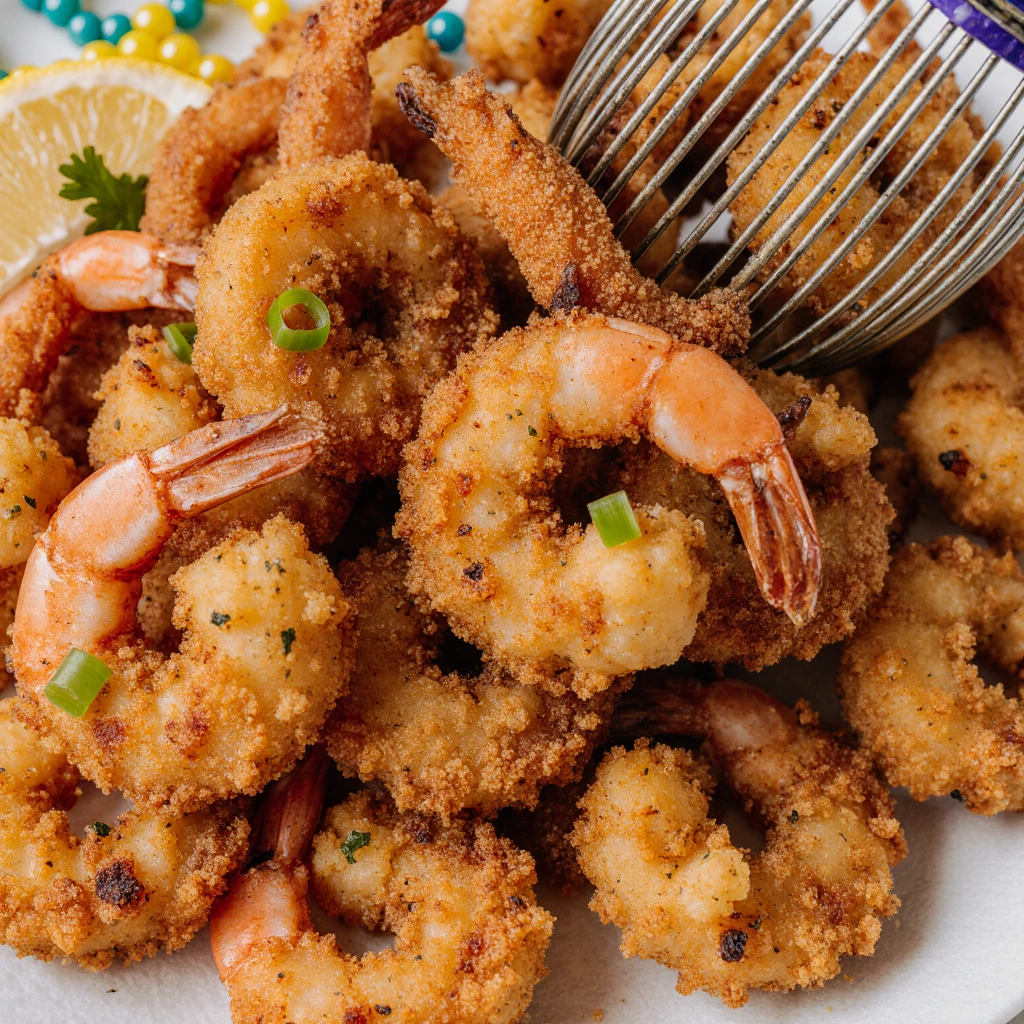
Nutritional Information
New Orleans fried shrimp provides substantial nutritional value when prepared with quality ingredients and consumed as part of a balanced diet. Understanding the nutritional profile helps home cooks make informed decisions about portion sizes and meal planning.
Per Serving (4 ounces of prepared shrimp):
- Calories: 285
- Protein: 24 grams
- Carbohydrates: 18 grams
- Fat: 12 grams
- Saturated Fat: 2 grams
- Cholesterol: 185 milligrams
- Sodium: 420 milligrams
- Fiber: 1 gram
- Sugar: 2 grams
Shrimp provides high-quality complete protein while remaining relatively low in calories compared to other fried seafood options. The protein content supports muscle maintenance and satiety, while the moderate fat content primarily comes from the frying oil rather than the shrimp itself. The carbohydrate content derives from the flour and cornmeal breading, providing energy for active lifestyles.
The dish contains significant amounts of selenium, vitamin B12, and phosphorus, essential nutrients that support immune function, nervous system health, and bone strength. The iodine content supports thyroid function, while the omega-3 fatty acids present in shrimp contribute to cardiovascular health.
Healthier Alternatives for the Recipe
Creating nutritious variations of New Orleans fried shrimp maintains the dish’s appeal while addressing diverse dietary needs and health considerations. These modifications preserve the authentic flavors while reducing calories, unhealthy fats, or problematic ingredients.
Air Fryer Adaptation: Replace traditional deep frying with air fryer cooking at 400°F for 8-10 minutes, lightly spraying breaded shrimp with cooking oil for browning. This method reduces oil content by approximately 75% while maintaining crispy texture.
Baked Version: Arrange breaded shrimp on parchment-lined baking sheets, drizzle with olive oil, and bake at 425°F for 12-15 minutes, flipping once. This technique eliminates deep frying entirely while preserving the seasoned coating.
Gluten-Free Option: Substitute all-purpose flour with almond flour or gluten-free flour blend, maintaining the same proportions and seasoning ratios. This modification accommodates celiac disease and gluten sensitivity without compromising flavor.
Reduced Sodium Version: Decrease salt content by half and enhance flavor with additional herbs such as dried thyme, oregano, or fresh parsley. Lemon zest adds brightness without increasing sodium levels.
Whole Grain Enhancement: Replace regular flour with whole wheat flour or add ground flaxseed to the breading mixture for increased fiber content and nutritional density.
Dairy-Free Alternative: Substitute buttermilk with coconut milk or almond milk combined with lemon juice for similar tenderizing effects without dairy components.
Serving Suggestions
New Orleans fried shrimp adapts beautifully to various presentation styles, from casual family dinners to elegant entertaining scenarios. These serving recommendations enhance the dining experience while honoring the dish’s cultural heritage.
Traditional Po’ Boy Presentation: Serve on crusty French bread with shredded lettuce, sliced tomatoes, pickles, and remoulade sauce for an authentic New Orleans sandwich experience. This classic preparation transforms the fried shrimp into a substantial meal that captures the essence of Louisiana street food culture.
Elegant Appetizer Plating: Arrange individual shrimp on small plates with dollops of spicy mayo, garnished with microgreens and lemon wedges for sophisticated entertaining. This presentation elevates the dish for dinner parties while maintaining its approachable nature.
Family-Style Sharing: Present on large platters with multiple dipping sauces including cocktail sauce, tartar sauce, and spicy remoulade, allowing guests to customize their experience. Include lemon wedges and fresh herbs for visual appeal and flavor enhancement.
Salad Integration: Top mixed greens with warm fried shrimp, cherry tomatoes, avocado, and creamy dressing for a satisfying main course salad that balances richness with fresh vegetables.
Taco Filling: Use as filling for soft flour tortillas with cabbage slaw, pico de gallo, and lime crema for a fusion approach that honors both Louisiana and Mexican culinary traditions.
Brunch Addition: Serve over cheese grits with sautéed vegetables for a hearty Southern brunch dish that combines multiple regional specialties in one memorable meal.
Common Mistakes to Avoid
Understanding frequent preparation errors prevents disappointing results and ensures consistent success when preparing New Orleans fried shrimp. These insights combine technical knowledge with practical experience to address the most challenging aspects of the cooking process.
Overcrowding the Frying Pan: Adding too many shrimp simultaneously reduces oil temperature by up to 50°F, resulting in greasy, unevenly cooked seafood. Research indicates that maintaining proper oil temperature requires limiting each batch to no more than 6-8 large shrimp, depending on pan size.
Insufficient Oil Temperature Monitoring: Cooking without a thermometer leads to inconsistent results, as visual cues alone prove unreliable for determining proper frying temperature. Oil that appears ready may actually be 25-75°F below optimal temperature, causing soggy breading and oil absorption.
Over-Marinating the Shrimp: Extended exposure to acidic buttermilk beyond 30 minutes breaks down protein structure excessively, creating mushy texture that compromises the final dish quality. The enzymatic action that tenderizes shrimp continues throughout the marinating period, requiring careful timing.
Inadequate Seasoning Distribution: Failing to mix dry ingredients thoroughly results in uneven flavor distribution, with some shrimp receiving excessive spice while others lack seasoning entirely. Professional chefs recommend sifting dry ingredients together to ensure uniform distribution.
Premature Draining: Removing shrimp from oil before achieving proper golden brown color results in pale, undercooked breading that lacks the signature crunch associated with quality fried seafood. Visual cues include floating behavior and rich amber coloring.
Incorrect Shrimp Size Selection: Using small or medium shrimp increases the risk of overcooking, as the brief frying time designed for large shrimp proves excessive for smaller varieties. Large shrimp provide the optimal ratio of coating to protein for balanced results.
Storing Tips for the Recipe
Proper storage techniques preserve the quality and safety of New Orleans fried shrimp while maintaining food safety standards. These recommendations address both short-term storage for leftovers and advance preparation strategies for meal planning.
Immediate Storage: Cool fried shrimp to room temperature within two hours of cooking, then refrigerate in airtight containers for up to three days. Avoid stacking hot shrimp, as trapped steam softens the crispy coating and promotes bacterial growth.
Reheating Methods: Restore crispiness using oven reheating at 350°F for 5-7 minutes rather than microwave heating, which creates soggy texture. Air fryer reheating at 375°F for 3-4 minutes provides excellent results for small quantities.
Freezing Capabilities: Freeze cooked fried shrimp for up to one month in freezer-safe containers, separating layers with parchment paper to prevent sticking. Thaw overnight in refrigerator before reheating to ensure even warming.
Advance Preparation: Bread raw shrimp up to four hours before frying, storing covered in refrigerator until ready to cook. This technique allows for party preparation while maintaining coating adhesion and food safety.
Component Storage: Store leftover breading mixture in sealed containers for up to one week, making future preparations more efficient. The seasoned flour blend maintains flavor potency when properly stored away from moisture and heat.
Oil Management: Strain and store frying oil for reuse up to three times when used exclusively for seafood, filtering through cheesecloth to remove food particles that cause rancidity and off-flavors.
Conclusion
This comprehensive New Orleans fried shrimp recipe delivers restaurant-quality results through precise technique, quality ingredients, and proper timing. The combination of buttermilk marination, seasoned cornmeal breading, and controlled frying temperature creates the signature texture and flavor that defines this Louisiana classic.
We encourage you to try this recipe and share your results in our review section. Leave comments about your variations and serving suggestions to help fellow home cooks perfect their technique. Subscribe to our blog for more authentic regional recipes and cooking tips that bring restaurant-quality results to your home kitchen.

FAQs
Q: Can I use frozen shrimp for this recipe? A: Yes, but ensure complete thawing and thorough patting dry before marinating. Frozen shrimp contains more moisture, which can dilute the buttermilk marinade and affect breading adherence. Allow extra time for thawing and moisture removal.
Q: What oil temperature is best for frying? A: Maintain oil temperature at 350°F (175°C) for optimal results. This temperature cooks the shrimp quickly while creating crispy breading without burning. Use a thermometer for accuracy, as visual cues prove unreliable.
Q: How can I make the breading extra crispy? A: Double-dredge the shrimp by repeating the buttermilk and breading process twice. This creates a thicker coating that stays crispier longer. Additionally, let breaded shrimp rest for 5 minutes before frying to improve adherence.
Q: What size shrimp works best? A: Large shrimp (21-25 count per pound) provide the ideal ratio of coating to protein. Smaller shrimp cook too quickly and may become tough, while jumbo shrimp require longer cooking times that risk burning the breading.
Q: Can I prepare the breading mixture in advance? A: Absolutely. The seasoned flour mixture stores well in airtight containers for up to one week. Prepare larger batches for convenience, as the blend works excellently for other fried seafood applications.
Q: Why does my breading fall off during frying? A: This typically results from insufficient marinating time, excess moisture on shrimp, or improper oil temperature. Ensure shrimp marinates for at least 15 minutes, pat partially dry before breading, and maintain proper frying temperature throughout cooking.
Warm up with a comforting bowl from our (soups) section, featuring rich broths and fresh ingredients.

